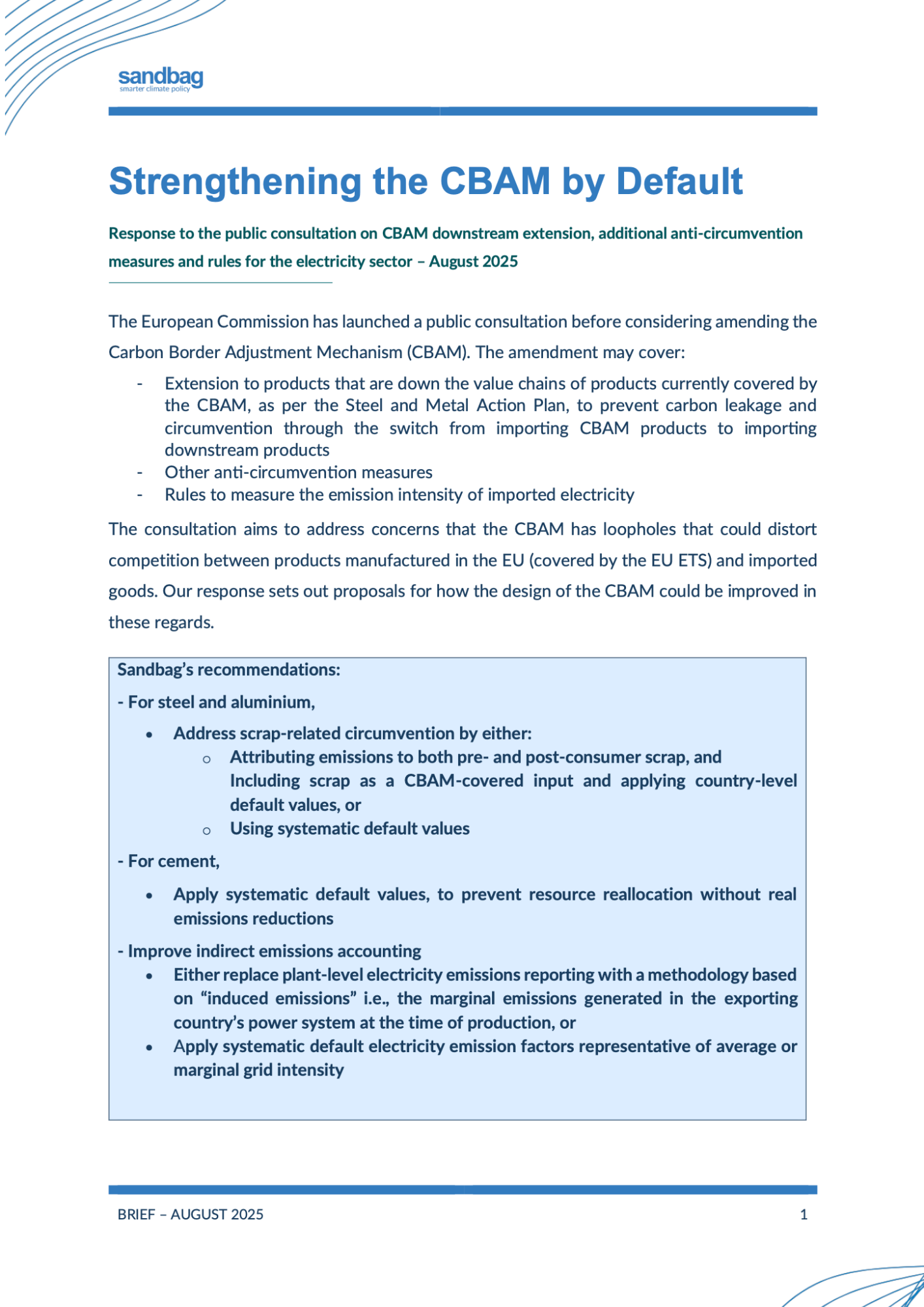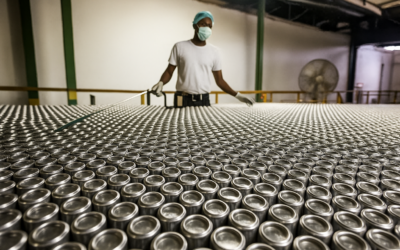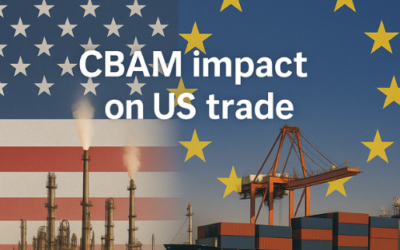The European Commission has launched a public consultation before considering amending the Carbon Border Adjustment Mechanism (CBAM). The amendment may cover:
- Extension to products that are down the value chains of products currently covered by the CBAM, as per the Steel and Metal Action Plan, to prevent carbon leakage and circumvention through the switch from importing CBAM products to importing downstream products
- Other anti-circumvention measures
- Rules to measure the emission intensity of imported electricity

The consultation aims to address concerns that the CBAM has loopholes that could distort competition between products manufactured in the EU (covered by the EU ETS) and imported goods. Our response sets out proposals for how the design of the CBAM could be improved in these regards.
Sandbag’s recommendations
– For steel and aluminium,
• Address scrap-related circumvention by either:
o Attributing emissions to both pre- and post-consumer scrap, and
Including scrap as a CBAM-covered input and applying country-level default values, or
o Using systematic default values
– For cement,
• Apply systematic default values, to prevent resource reallocation without real emissions reductions
– Improve indirect emissions accounting
• Either replace plant-level electricity emissions reporting with a methodology based on “induced emissions” i.e., the marginal emissions generated in the exporting country’s power system at the time of production, or
• Apply systematic default electricity emission factors representative of average or marginal grid intensity
– Strengthen coverage of electricity imports
• When electricity is imported as a product, emissions should be reported based on the marginal generation impact of exports to the EU, not the nominal carbon content of a direct supply or PPA
– Facilitate downstream extension through systematic use of default values
• Extend CBAM to downstream products by using systematic, country-level default values for emissions embedded in inputs, avoiding the complexity of plant-level traceability across global value chains
– Promote international acceptance through transparency and fairness
• Engage with third countries to build support for default-based reporting, highlighting benefits such as:
o Reduced administrative burden
o Protection of commercially sensitive facility data
o A system that encourages systemic decarbonisation at the national level
Anti-circumvention: avoiding loopholes
The current approach of emissions reporting under the Commission Implementing Regulation (EU) 2023/1773 consists of measuring actual embedded emissions of imported products by tracing them back to the individual manufacturing plants where they were produced.
Although third countries should be encouraged to gather granular, verifiable emissions data, there is a risk that the current reporting approach creates incentives for EU trade partners to selectively export products to the EU which, thanks to current loopholes, would not represent genuine climate benefits; a practice known as “resource shuffling”. This also undermines the CBAM’s main objective of preventing the risk of carbon leakage.
Example 1: Steel and aluminium scrap
Both steel and aluminium are already collected and recycled widely in most countries, either in their pure forms or blended with freshly transformed primary materials to create new products. However, the emissions reporting method currently in place assumes that steel and aluminium scrap has no embedded emissions. Steel and aluminium exporters can therefore reduce the CBAM fees charged for their products by strategically blending larger amounts of scrap into products sold to the EU (subject to CBAM fees) and less for products sold to other markets (not covered by CBAM fees), without reducing any emissions.
Such circumvention is possible under the current rules. Some companies already commercialise aluminium ingots made from 75% post-consumer scrap as equivalent to primary aluminium quality. For steel, long products are commonly made from 100% scrap in the EU, whereas flat products can be made from up to 80% through the electric arc furnace route. All that is needed is good quality scrap, so exporters just need to reserve their top-quality scrap for the products sold to the EU. Easier still, they can use pre-consumer scrap (produced at the factory), which is also considered as carbon-free under the current CBAM methodologies.
Sandbag first flagged the scrap problem to the CBAM Expert Group in 2023 (see Mind the Scrap: Ignoring Embedded Emissions Puts the CBAM at Risk) and again in our response to the public consultation on reporting requirements. In 2024, we estimated its potential impact on profits for importers (see A Scrap Game: Impacts of the EU Carbon Border Adjustment Mechanism), and we wrote a joint oped with partners on this topic.
In December 2024, we proposed to the CBAM Expert Group two ways of closing the scrap loophole (see For a systematic use of default values in the CBAM), either:
- by changing the reporting requirement in such a way as to attribute embedded emissions to scrap, or
- by reporting embedded emissions based on default values only, instead of actual data.
The first solution only solves the problem for steel and aluminium scrap, whereas the second solution also closes other loopholes and has other advantages. With the first solution, we also proposed to apply different levels of discount for free allocation between pre- and post-consumer scrap.
Example 2: Low-clinker cement
Clinker is a very carbon-intensive component of cement, but it is possible to produce high quality cement by replacing clinker with industrial residues such as blast furnace slag or fly ash from coal power stations. These residues are commonly used (to the extent of their availability) to reduce the cost of cement. Although they come from carbon-intensive industries, they are currently considered as zero-emission by the CBAM methodology.
For third countries, it is therefore possible to significantly reduce the CBAM charges applied to their Portland cement (or other high-clinker types of cement products) by selling low-clinker cement instead, and keeping Portland cement for their domestic market – without creating real benefits for the climate.
This kind of resource shuffling could be avoided by using default values only (based on emission averages for a third country or a group of third countries) instead of actual data in the reporting of embedded emissions.
Example 3: Indirect emissions (from the use of electricity)
With the current method of reporting under the CBAM, emissions attributed to use of electricity in the manufacturing of goods are either based on the country’s grid emission factor or, if the manufacturing plant has a direct link or a power purchase agreement (PPA) with a renewable energy source (RES), counted as zero.
It is therefore possible for third country exporters to reduce their CBAM fees by signing PPAs or connecting their factories to existing RES, without benefit for the climate. Again, this could be avoided through systematic use of default values.
Alternatively, an even better way of calculating indirect emissions should take into account the impact of the manufacturing plant on the (marginal) power sector emission of the exporting country, rather than the emissions of the power plant specifically used for the goods.
If the plant only functions at times of abundant low-carbon electricity in the grid, then the plant creates no extra need for fossil electricity generation in the country and its electricity should be considered as carbon free, regardless of being connected to a RES (directly or through a PPA). In contrast, if the plant functions at times of high electricity demand, it will create extra demand for fossil electricity generation even if it uses a dedicated RES, because that RES ends up not meeting the broader demand. In this case, the plant creates induced fossil power generation and induced GHG emissions (see Getting Electrification Right: The broader challenge of induced emissions).
A better calculation method would estimate the emissions induced by the goods’ manufacturing plant, which should use the emission intensity of marginal power plants at the time when the goods’ manufacturing plant operates. This would only make sense for plants that can run at specific times (i.e. not 24 hours) and can reliably report the timing of their operations, whereas in other cases default values are more appropriate.
Downstream extension
We support the European Commission’s intention to extend CBAM to downstream products, particularly where there is a high risk of circumvention through shifting production down the value chain. However, extending the CBAM to products down the value chain of existing CBAM products could make reporting quite complex, if for example the product is made of hundreds of subparts. This complexity could be dramatically reduced if default values were used at all levels, instead of actual reporting. Such a method would still require tracing the country of origin of each subpart and even of the precursors used in each subpart, but not individual manufacturing plants.
Electricity imports
The reported emission intensity of electricity imports is currently based on fossil-based default values, unless the electricity comes from a low-carbon source of electricity (either through a direct connection or a PPA). We agree that default values should reflect fossil power generation, because the EU is more likely to import electricity at times of low availability of fossil-free electricity domestically, which is likely to correspond to similar periods in bordering countries.
However, actual reporting should not be based on the connection to a particular source of electricity. Instead, it should take into account the impact of the sale of electricity to the EU on the (marginal) power sector emission of the exporting country. This is because a PPA or direct connection to renewable electricity does not necessarily reduce fossil-based generation if it occurs during periods of high demand. If the electricity is exported at times of abundant low-carbon electricity in the (exporting) grid, then the sale creates no extra need for fossil electricity generation in the (exporting) country and its electricity should be considered as carbon free.
In contrast, if the electricity is sold at times of high electricity demand in the country of origin, the sale to the EU will create extra demand for fossil generation even if the electricity comes from a RES. In this case, the power sale creates induced fossil power generation and induced GHG emissions (see Sandbag (2025) Getting Electrification Right: The broader challenge of induced emissions). A better calculation method would consist of estimating the emissions induced by the sale of electricity to the EU, which should use the emission intensity of marginal power plants at the time of the sale.
Acceptability for third countries
In the above examples, we have provided different solutions to prevent circumvention of CBAM fees. In some cases, one of the solutions was a systematic use of default values. This could be done in compliance with WTO rules, if the EU could seek prior consent from trade partners before applying systematic default values. This consent may be sought for a selection of CBAM product types, and there would be good reasons for our trade partners to agree with such a method:
– Simplified reporting: when given the option between actual and default values (until Q2 2024), only 5% declarants chose actual data. Even when default values were capped at 20% of emissions in Q3 2024, about 50% still claimed to use them.
-Data disclosure: reporting actual data requires manufacturing facilities to share process and input information with external parties such as independent verifiers. Some exporting countries might be reluctant to do so. A system based on national or regional default values allows countries to maintain control over sensitive industrial data while still participating in the CBAM on fair and transparent terms.
– Reduced administrative and cost burden: Individual reporting by exporters requires them to engage in verification processes involving accredited third-party auditors, which can be both costly and resource-intensive particularly for small producers or countries with limited technical capacity. Default values made publicly available would mean the CBAM is accessible to all trade partners regardless of institutional capacity.
– More representative default values: if default values are optional, they are likely to be set conservatively high to prevent selective use by high-emitting producers. If default values were applied more systematically, they could instead be set at the country average without risk of under-reporting. Third countries thus have an interest in opting out of actual emission reporting. The use of systematic default values based on country-wide average emission intensities also creates stronger incentives for systemic emission reductions from our trade partners.
Related publications
Chemicals in the CBAM: Time to step up
Sandbag’s latest brief explains why the EU CBAM must be expanded to cover key chemical value chains. With chemicals and refinery products responsible for 30% of industry emissions, phased inclusion is critical to prevent carbon leakage and phase out free allowances.
The EU CBAM: a two-way street between the EU and Africa
Sandbag’s newly released CBAM Simulator allowed us to explore how the EU’s Carbon Border Adjustment Mechanism (CBAM) could impact African exporters — and how cleaner production and carbon pricing could turn a cost into a competitive edge.
CBAM impact on US trade: an analysis
Sandbag’s September 2025 research note explores the impact of the EU’s CBAM on US exports. It finds that even with expanded scope, the financial impact remains marginal — and US carbon pricing could turn net costs negative.



